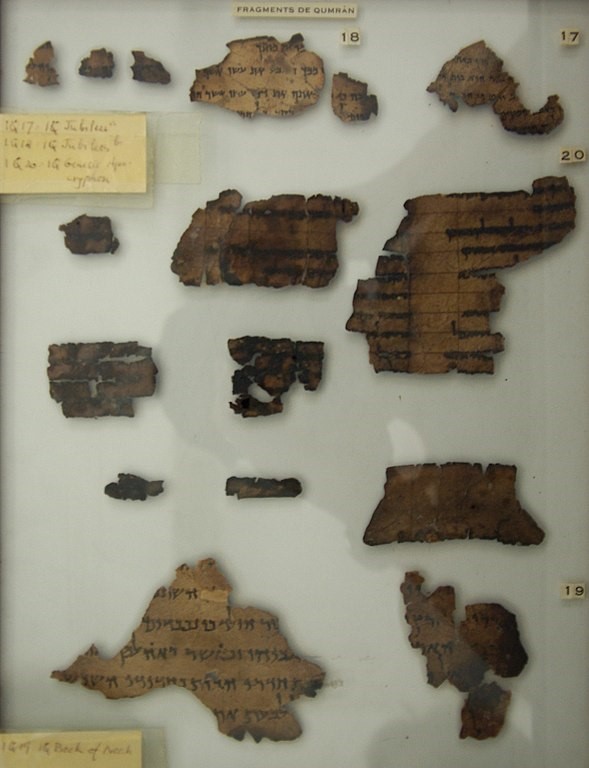イスラエルの研究者と考古学者は16日、半世紀ぶりに新たに発見された「死海文書」とされる聖書の巻物の断片など、いくつかの画期的な発見を発表した。
[toggle]Israeli researchers and archaeologists unveiled this week several groundbreaking discoveries, including dozens of biblical scroll fragments that represent the first newly uncovered Dead Sea Scrolls in more than half a century.[/toggle]
死海文書(写真:Berthold Werner)
「死海文書」には、紀元前3~2世紀の聖書テキストなど、最初期とされるユダヤ教宗教文書の一部が含まれている。この写本は第二次世界大戦直後、クムランとユダヤ砂漠近くの洞窟(どうくつ)で最初に発掘された。
[toggle]The Dead Sea Scrolls contain some of the earliest known Jewish religious documents, including biblical texts, dated from the third century B.C. to the second century A.D. The manuscripts were first unearthed in the immediate aftermath of World War II in the caves near Qumran and the Judean Desert.[/toggle]新しい断片についての最初の報告からでも(これから何年もかかってそれらは分析され、精査されるだろう)、最初期の聖書テキストがどう翻訳され、私たちのようなやり方で翻案されたか、いくつかのエキサイティングな発見がある。
[toggle]Even an initial review of the new fragments—which will be analyzed and scrutinized for years to come—offers some exciting findings about how the earliest biblical texts were translated and adapted in ways like our own.[/toggle]裕福な収集家が貴重な巻物の残りの断片を手に入れたいと望み、過去数年間に古美術品の需要が急増し、略奪や偽造に拍車がかかった時に、こうした発見がなされた。
[toggle]The discovery comes at a time when demand for antiquities has skyrocketed, spurring looting and forgeries over the past several years as wealthy collectors hope to acquire any remaining scraps of the priceless scrolls.[/toggle]2002年頃から、疑わしい起源の物語とともに広く公表された「死海文書」の断片が数多く出現した。遺物や巻物を手に入れるための一連の違法な試みの後、イスラエル考古学庁は、ユダヤ砂漠の崖に沿って存在する洞窟内部を再調査するため、考古学的調査を継続的に実施した。
[toggle]Starting around 2002, a number of widely publicized “Dead Sea Scroll” fragments emerged with questionable origin stories. After a series of illegal attempts to acquire artifacts and scrolls, Israeli Antiquities Authority conducted a series of archaeological surveys to reexamine the interiors of the caves along the cliffs of the Judean Desert.[/toggle]2017年から研究者たちは、死海の西岸近くにある、いわゆる「恐怖の洞窟」から、それぞれわずか数センチの大きさの20個の巻物の断片を発見した。ここは、西暦133〜136年、ローマ帝国に対する「バル・コクバの乱」(第二次ユダヤ戦争)の際に反乱軍が隠れていたと考えられていた場所だ。「恐怖の洞窟」という名称は、数十年前の最初の発掘調査で40体の遺体が発見されたことに由来している。
[toggle]Beginning in 2017, its researchers uncovered two dozen scroll pieces, each measuring only a few centimeters across, from the so-called Cave of Horror near the western shore of the Dead Sea. It’s a site where insurgents were believed to have hidden during the uprising led by Simon bar Kokhba against the Roman empire in A.D. 133–136. It gets its name from the discovery of 40 bodies during initial excavations decades before.[/toggle]ほとんどの「死海文書」はヘブライ語とアラム語で書かれているが、「恐怖の洞窟」で発見された断片にはギリシア文字が含まれていた。学者たちはそれを、ヘブライ語聖書の「12巻」(多くのクリスチャンはそれを「小預言書」と呼んでいる)をギリシア語に翻訳したものと判断した。
[toggle]Unlike most of the Dead Sea Scrolls, which were written in Hebrew and Aramaic, the fragments from the Cave of Horror contain Greek letters. Scholars determined they came from a Greek translation of the Book of the Twelve in Hebrew, what many Christians call the Minor Prophets.[/toggle]元の文書を再構築する作業は、ほんの一握りのピースで1000ピースのジグソーパズルを完成させようとすることに似ている。最大の断片にはゼカリヤ書8章16~17節の一部が記されており、いくつかの小さな断片はナホム書1章5~6節と識別されている。これらは、「ナハル・ヘベル」という古代の峡谷に沿った同じ洞窟から以前に発見された他の断片に関連しているようであり、すべての小預言書を含む単一の大きな巻物の一部だったと思われる。
[toggle]The job of reconstructing the original document is akin to trying to assemble a thousand-piece jigsaw puzzle with only a handful of pieces. The largest fragment contains portions of Zechariah 8:16–17, and some smaller bits are identified as Nahum 1:5–6. These pieces appear to be connected to other previously discovered fragments from the same cave along the ancient gorge of Nahal Hever and were part of a single large scroll including all of the minor prophets.[/toggle]この聖書テキストは、私たちが持つギリシア語聖書の最も古い巻物に由来しているが、これによって標準的なギリシア語翻訳聖書(しばしば「70人訳聖書」「セプトゥアギンタ」「LXX」と呼ばれる)の発展や改訂をおそらく見ることができるだろう。(後編に続く)
[toggle]The text comes from the oldest physical scroll of the Greek Bible we have, but it likely represents a development or revision of the standard Greek translation—often referred to as the Septuagint, LXX, or Old Greek.[/toggle]